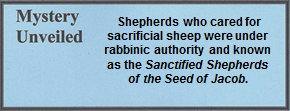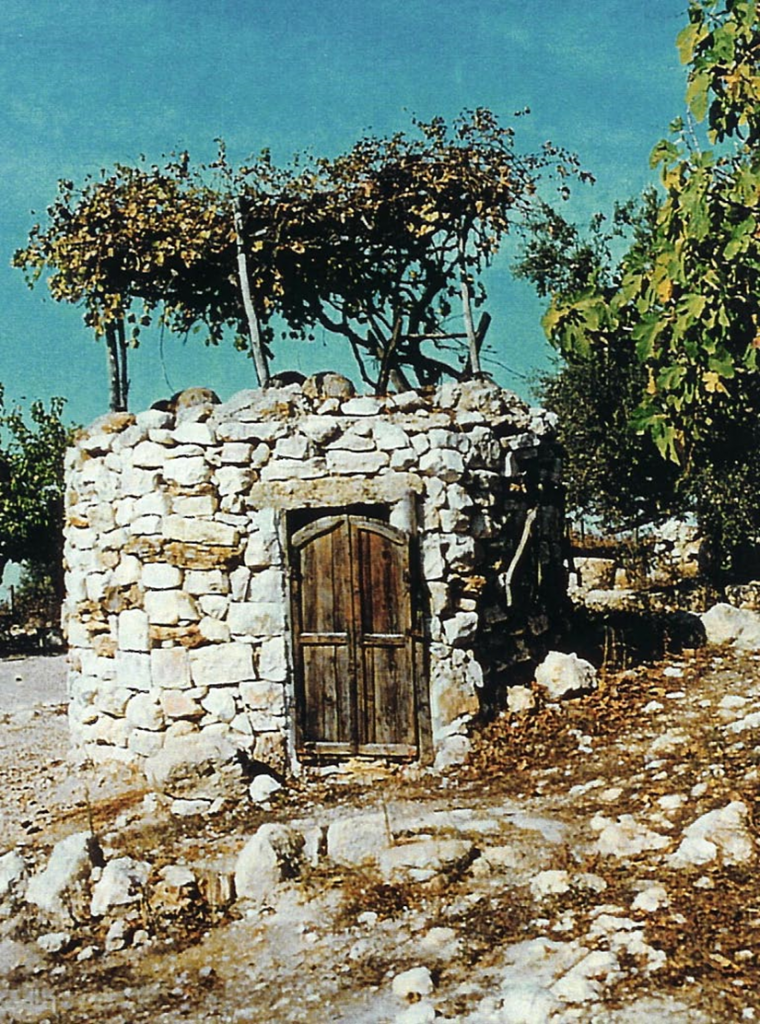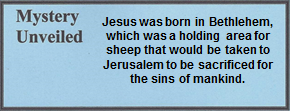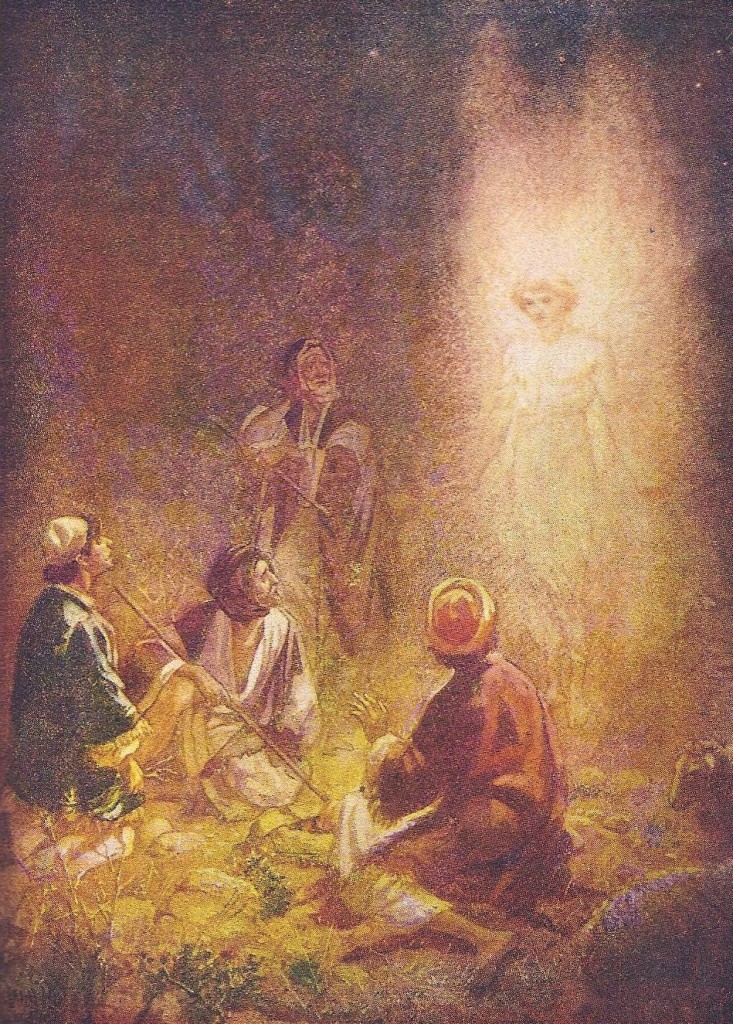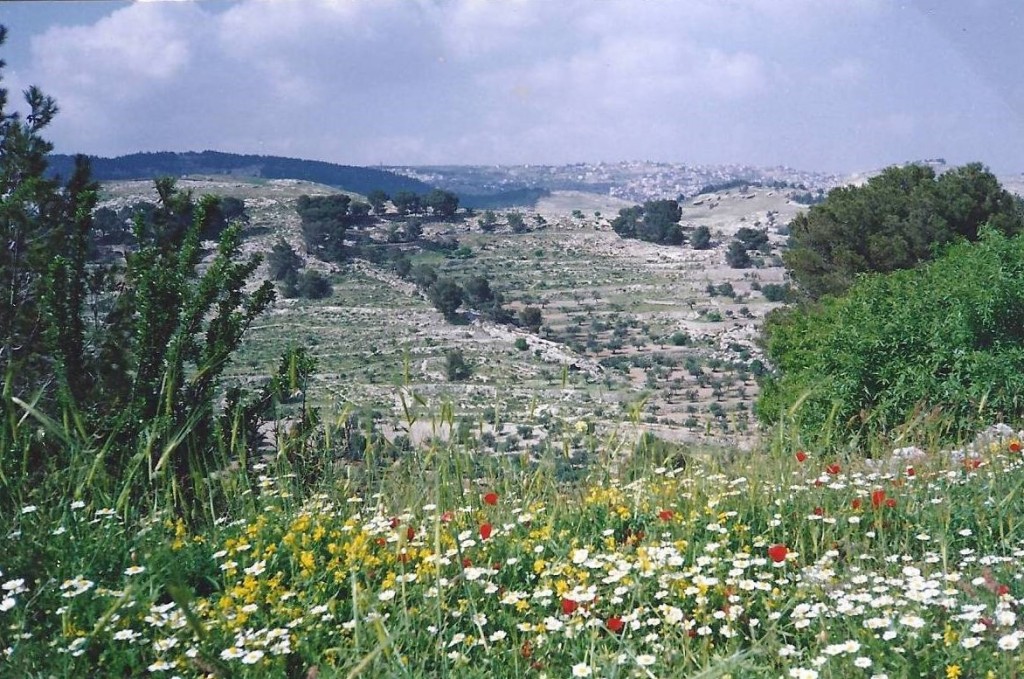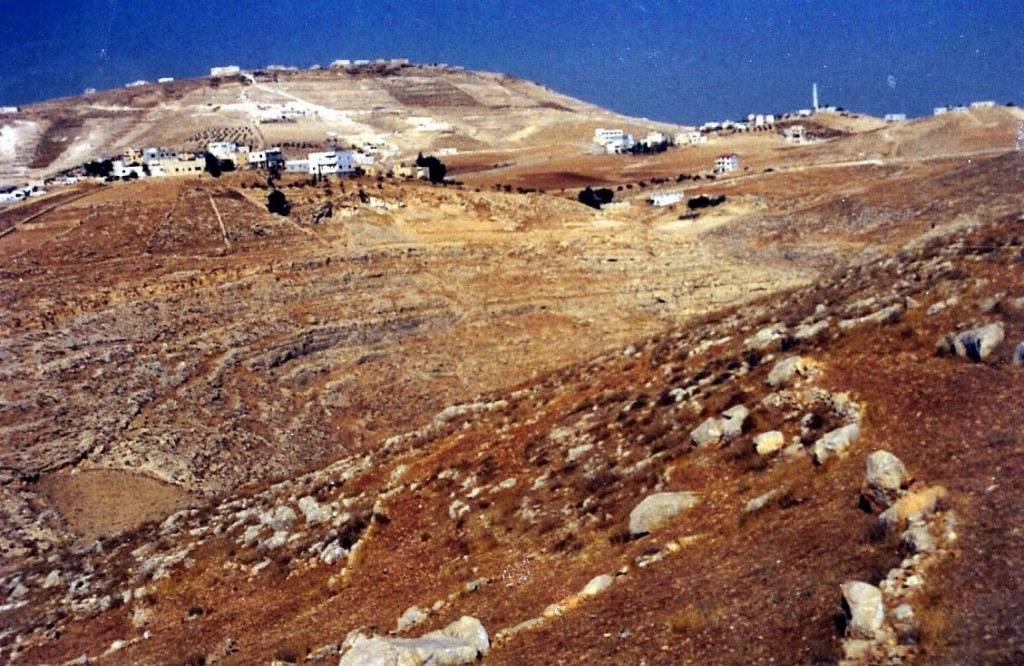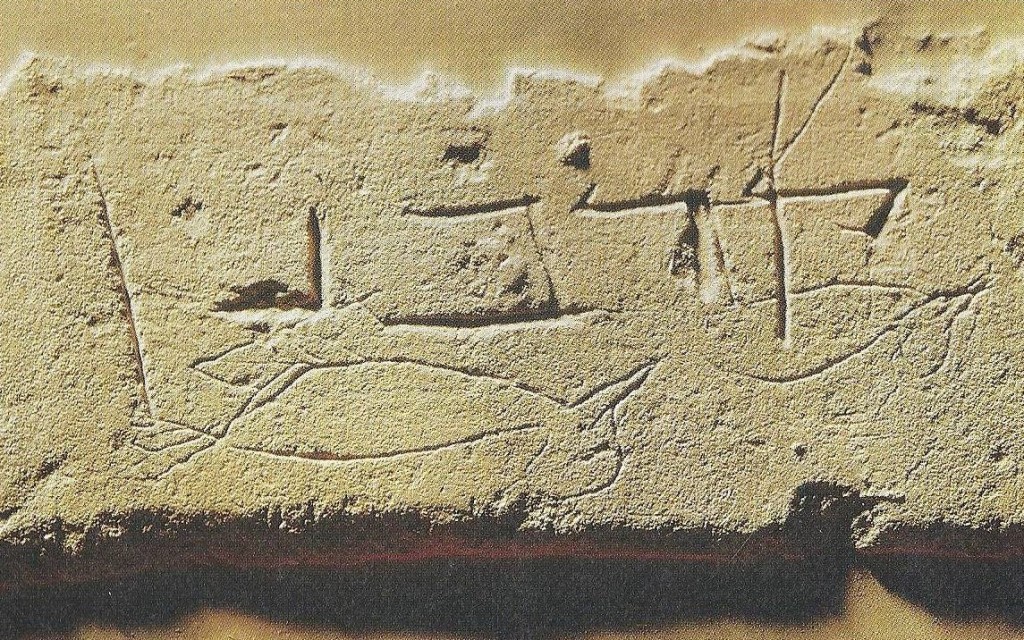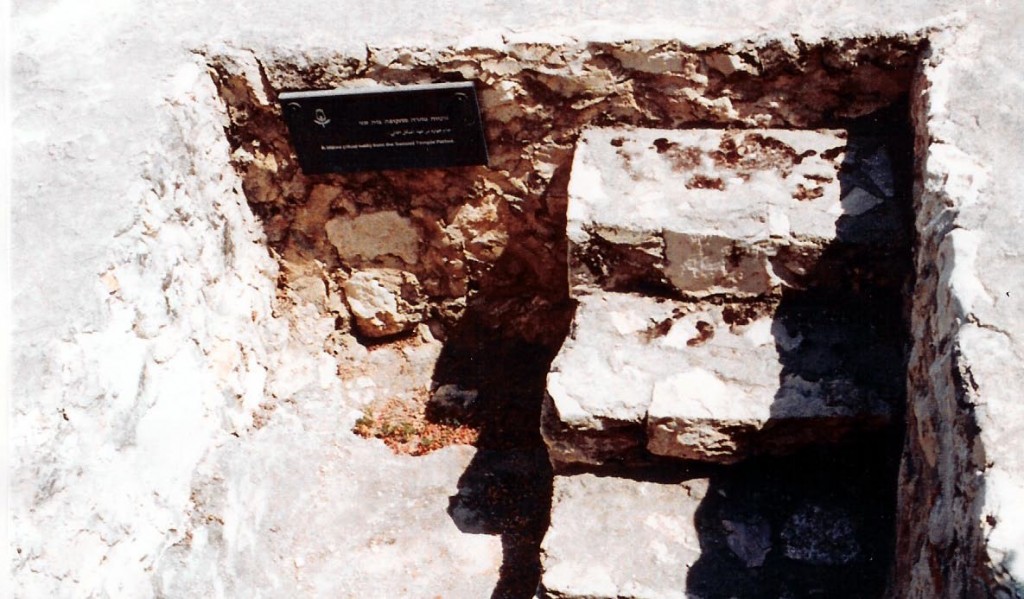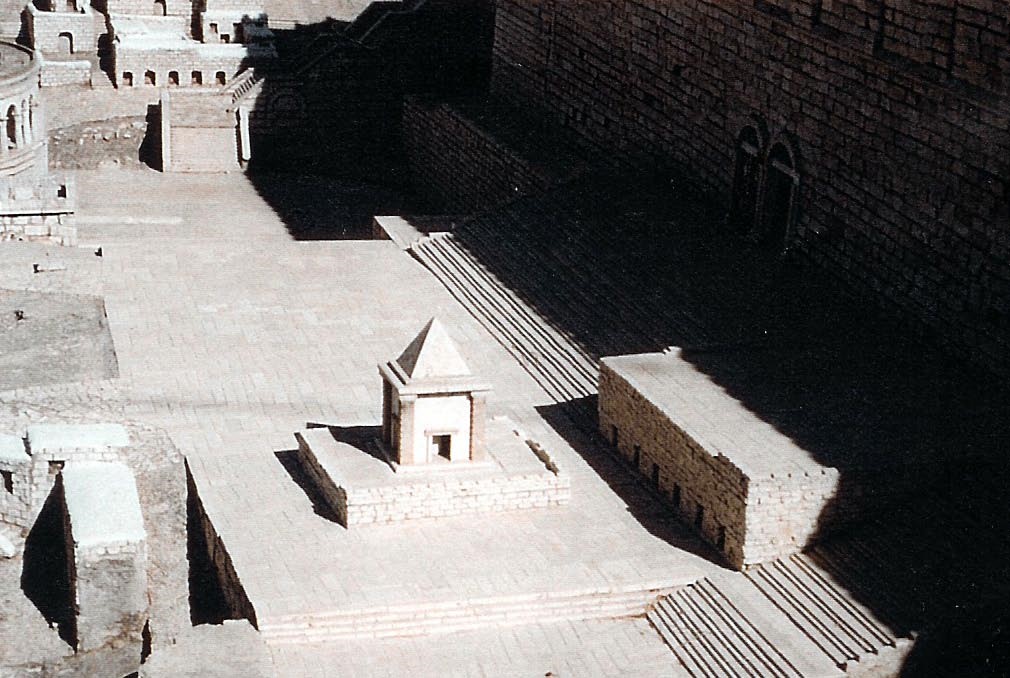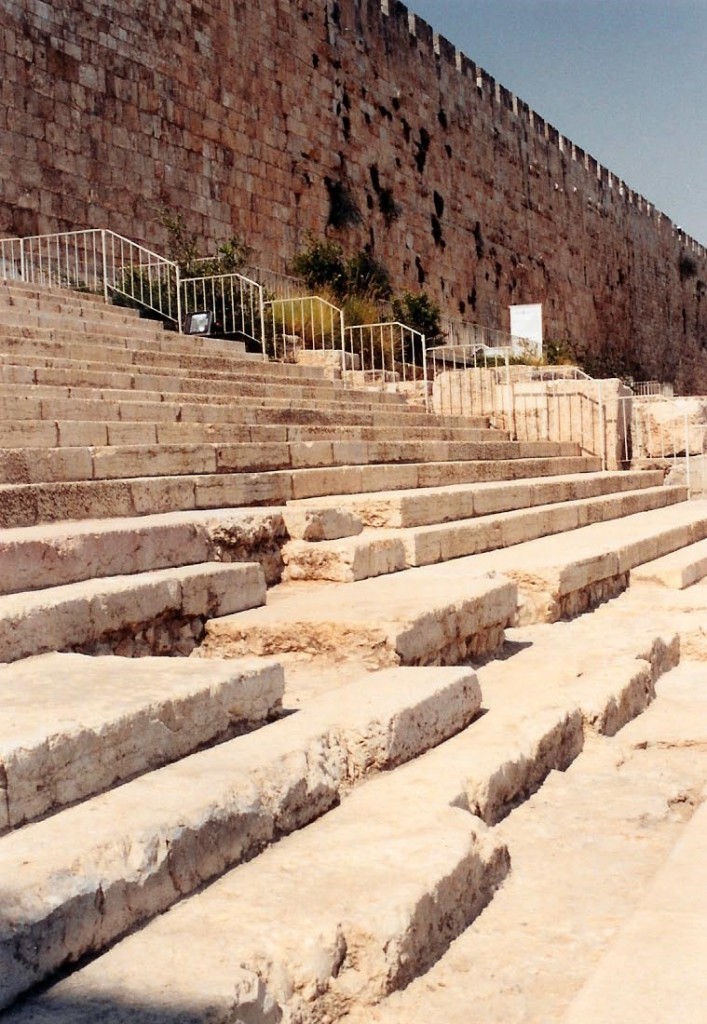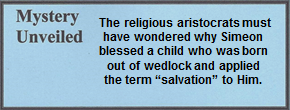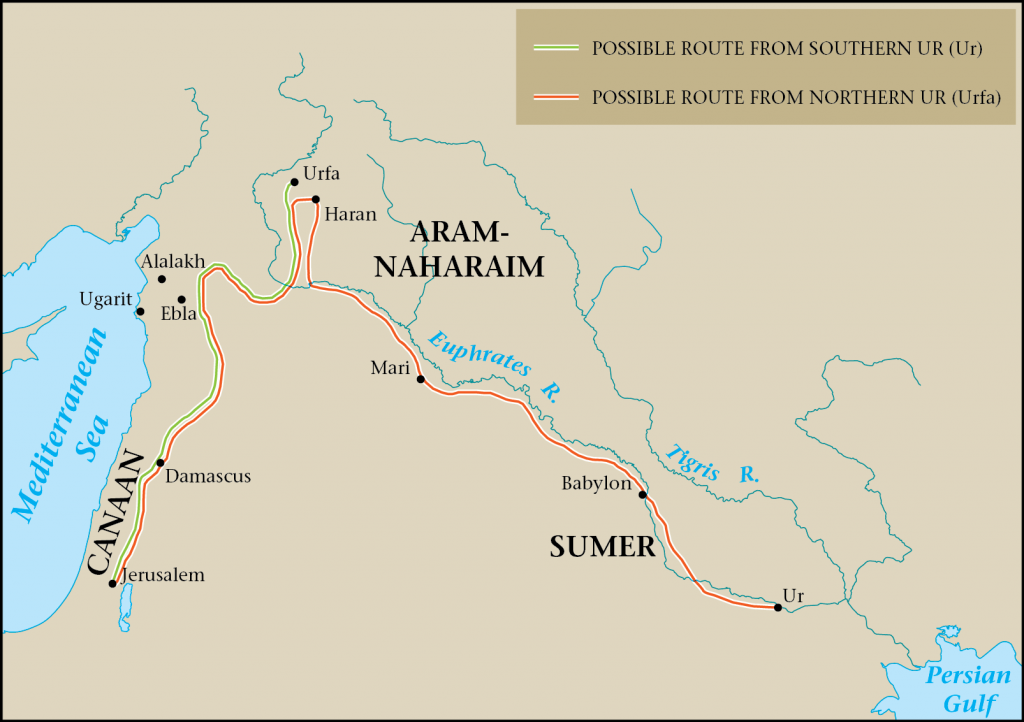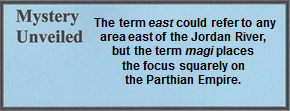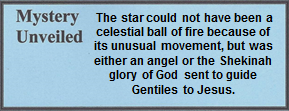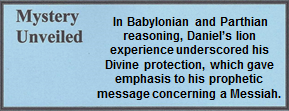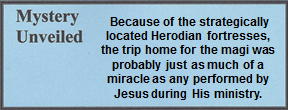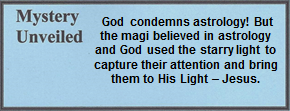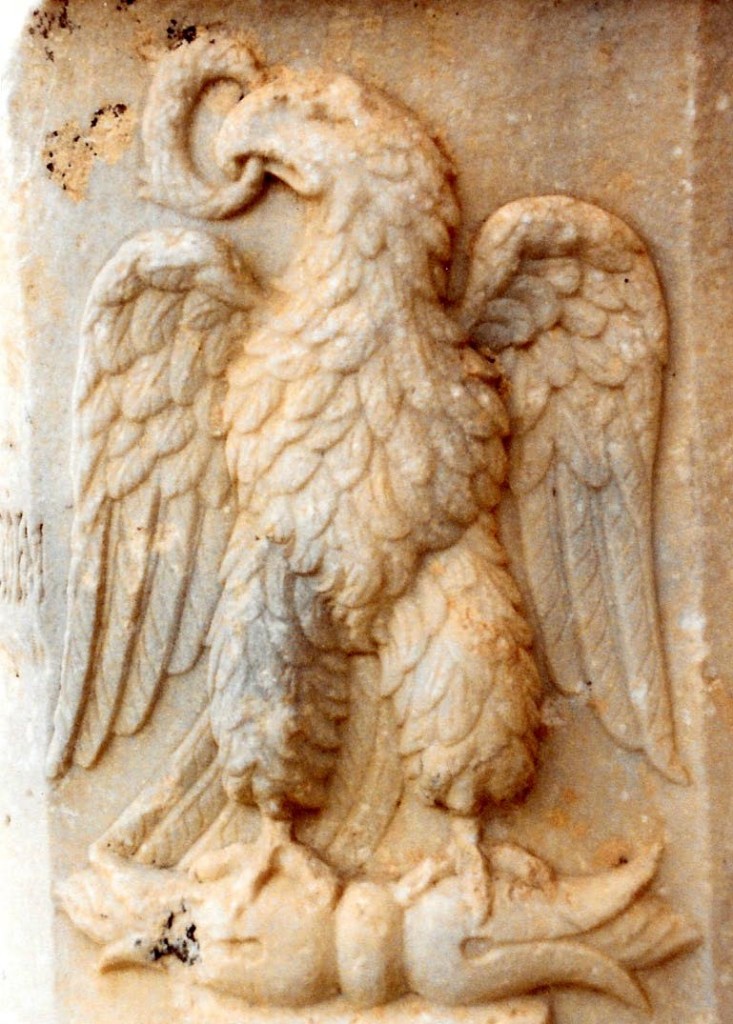04.03.10 Lk. 2:4-7 Bethlehem
THE BIRTH OF JESUS
4 And Joseph also went up from the town of Nazareth in Galilee, to Judea, to the city of David, which is called Bethlehem, because he was of the house and family line of David, 5 to be registered along with Mary, who was engaged to him and was pregnant. 6 While they were there, the time came for her to give birth. 7 Then she gave birth to her firstborn Son, and she wrapped Him snugly in cloth and laid Him in a feeding trough — because there was no room for them at the lodging place.
“Went up from the town of Nazareth.” This phrase of geographical direction clearly illustrates one of the many differences between modern Western thought and ancient Middle Eastern thought. When giving directions, most Western people today think going north as “up” and traveling south as “down.” Not in biblical times – they thought in terms of elevation. While Nazareth is on a hill top, Bethlehem is on top of a higher ridge, almost as high as Jerusalem which is 2,800 feet above sea level. Another example of this terminology is found in the psalms when the song writer says they are going “up to Jerusalem,” regardless of the direction they are coming from.
“The city of David, which is called Bethlehem.” Luke connected the birth of Jesus to King David. Bethlehem was identified as being in Judea so as to distinguish it from another village of the same name seven miles northwest of Nazareth in the tribal land of Zebulon (Jos. 19:15). If Jesus was the promised Messiah, then every prophecy about Him would be fulfilled in detail. This was important to Matthew. To say that Jesus was born in Bethlehem of Judea is a graphic way of saying that He is the “Son of David.”[1] No Jew would have missed the point!
The name of this small, seemingly insignificant village has an interesting history. In the ancient Canaanite Period it was known as “Beth-Lahame,” meaning the house of Lah. Later, under Assyrian domination the name was slightly modified. From the ancient Ugaritic (Assyrian) language is the borrowed word Lehem that honored the Assyrian god of war, Lakhmu, of the earlier Canaanite Period.[2] A point of interest is that the Assyrians relocated the ten northern Israelite tribes to the east, but they did not relocate the two southern tribes of Benjamin and Judea where Bethlehem is located.[3] In essence, the village of “Bethlehem,” eight centuries later was renamed Lehem, and became the place where the Prince of Peace was born.[4]
The Hebrew name Bethlehem is a combination of two words: Beth, which means, house or the house of, and lehem or lechem which means “bread.” Combined, that village name means the house of bread. But, in a broad sense, the term also means food[5] or all of man’s provisions.[6] It is Jesus, who is the Bread of Life and was born in a small obscure village named Bethlehem – of the same meaning. Since the 7th century Islamic invasion the historical name has been preserved in the Arabic Bayt Lahm, which is the equivalent of “Bethlehem.”[7] The place names of many communities have been preserved for thousands of years.
04.03.10.Q1 Where was Jesus born?
The birthplace of Jesus was hardly the quaint stable frequently seen in Christmas cards and decorations. Most of the mountains in central Judaea (modern Israel) are dry limestone, which developed caves. Westerners today tend to think of caves as wet, cold and having stalagmites and stalactites. But the caves of the Middle East are without these internal formations because the semi-arid climate conditions prevent their development. Rather, caves tend to be small, barely large enough for homes or to stable livestock during cold winter nights and hot summer days. If animals were kept indoors, they were in one of two possible places:
- Caves
- On the ground floor of homes[8]
Barns as are common today did not exist in the first century. Herds of flat-tailed sheep were gathered at night in large outdoor pens, but not indoors. Since many hills consist of soft limestone, some caves were enlarged to serve as living quarters adjacent to homes. Since the entire Middle East was filled with lions, bears, and other wild animals as well as thieves, animals of value such as an ox or donkey would have been placed in a cave or house to protect them. Likewise, sick or young animals were placed in homes for safekeeping and health maintenance.[9]
Concerning the place where Jesus was born, there was a strange irony of history that occurred about a century after Jesus. After A.D. 135 when Hadrian destroyed Jerusalem, he was determined to destroy any evidence of Judaism and Christianity. Therefore, when he found the cave of the Savior’s birth – the cave that had been used as a stable – he built a shrine on top of it to honor his pagan god Adonis[10] and planted a grove of trees around it.
Two centuries later the politics of Rome changed radically and Constantine became the first Christian emperor of Rome. To commemorate Christian sites, he sent his mother Queen Helena to the Holy Land to locate those that were significant to the life of Jesus and to build a church or basilica over each one. She found the shrine of Adonis built by Hadrian which preserved the identity of the site, and in the year 326 she ordered the construction of a basilica which is known as the Church of the Nativity.[11]
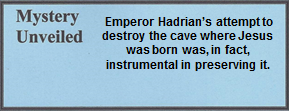
The structure was later partially destroyed, but in the sixth century, the Byzantine Emperor Justinian rebuilt it. During the Crusader era, it was expanded to what is seen today. The location of our Savior’s birth has a solid legacy. Similarly, his attempt to destroy the crucifixion site also became crucial to its preservation for the site identification and construction of the Church of the Holy Sepulchre.
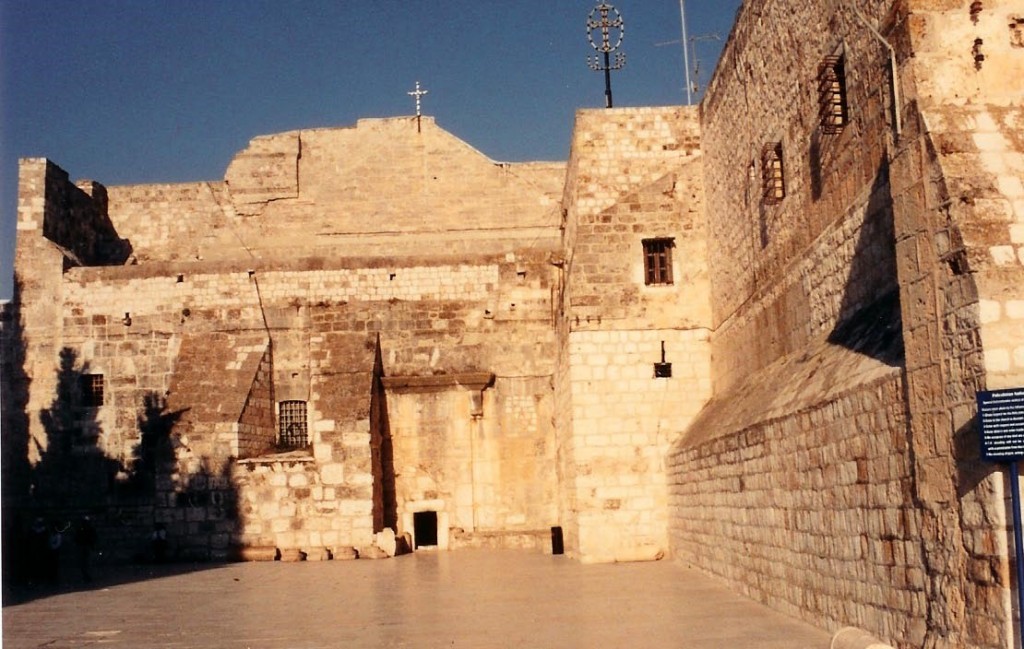
04.03.10.A. THE CHURCH OF THE NATIVITY. The original Church of the Nativity was a basilica constructed by Queen Helena in the early fourth century and many additions and changes have been made since then. The present church seen above was built by Justinian (c. 527-565) and expanded by the Crusaders.[12] The small doorway was constructed within a larger entrance by the Crusaders to prevent Arab horsemen from entering the house of worship.[13] Photograph by the author.
In the ancient Middle East, major historical events were the subjects of discussion long after the participating personalities had passed on. Within two decades of Hadrian, the early Church father Justin Martyr (c. 110-165) wrote of the cave where Jesus was born. He was an ardent defender of the faith and opposed a leading skeptic of his time by the name of Trypho. In a written defense titled Dialogue with Trypho, Justin mentioned Bethlehem as the place of the birth of Jesus. He wrote:
The child was born in Bethlehem. Since Joseph could not find lodging in that village and while they were there Mary brought forth the Christ and placed Him in a manger and here the magi who came from Arabia, found him.
Justin Martyr, Dialogue with Trypho 78[14]
Another writer, Origen (c. 250), was a highly respected defender of the faith. In his apologetic writings titled Against Celsus, Origen said that Jesus was born in a stable in a cave. Such stables had troughs, or mangers, cut from cretaceous limestone in which water or grain (usually barley) was placed for the animals.[15] His text reads,
With respect to the birth of Jesus in Bethlehem, if anyone desires, after the prophecy of Micah and after the history recorded in the Gospel by the disciples of Jesus, to have additional evidence from other sources, let him know that in conformity with the narrative in the Gospel regarding His birth, there is shown at Bethlehem the cave where he was born, and the manger in the cave where he was wrapped in swaddling clothes. And this site is greatly talked of in surrounding places. Even among the enemies of the faith, it being said that in this cave was born that Jesus who is worshiped and reverenced by the Christians.
Origen, Against Celsus 1:51[16]
Throughout Jewish history it was common for caves to be used for tombs, homes, stables, and temporary shelters.[17]
Homes generally had only two rooms, a family bedroom and another “family room,” which included a kitchen and was the only room in which guests were invited.[18] A third or fourth room was indicative of financial prosperity. The homes in which Jesus lived in Bethlehem, Nazareth, and Capernaum, were typical of the period; homes which were also shelters for valued domestic animals.[19] An example is found in 1 Samuel 28 where King Saul went to see the witch (medium) of Endor. She took a calf from “within her house” (v. 24), killed it, prepared it, and served the king and his servants. Jesus said in Matthew 5:14-15 that a lamp that has been lit will give light to the whole house. That was because houses were of simple design and consisted of a large room and a smaller sleeping room. The wall separating the two rooms often had square openings called “windows” through which fresh air flowed and allowed some light to shine in.
Families, who lived in areas that were not subject to freezing, such as Nazareth, the Sea of Galilee, or southern desert areas, often had open courtyards. At times four houses were constructed in such a manner that they enclosed a courtyard where children and livestock were safe.
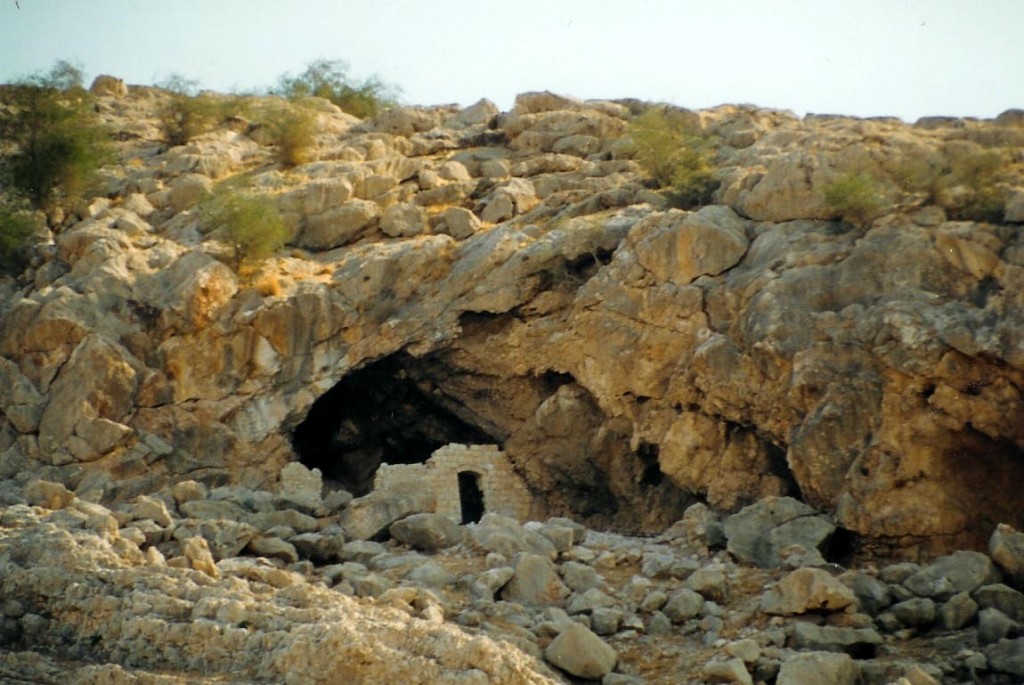 04.03.10.B. A MODERN CAVE STABLE. Caves in hillsides are still used for stables and homes as they were in the first century. Because of the semi-arid climate and the soil formation in the Middle East, caves are extremely dry, cool in the summer, and comfortable in the winter. These also tend to be rather small when compared to those in other geographical areas, primarily because of the frequent earthquakes. This one was photographed by the author in the hills overlooking the Jordan valley. Photograph by the author.
04.03.10.B. A MODERN CAVE STABLE. Caves in hillsides are still used for stables and homes as they were in the first century. Because of the semi-arid climate and the soil formation in the Middle East, caves are extremely dry, cool in the summer, and comfortable in the winter. These also tend to be rather small when compared to those in other geographical areas, primarily because of the frequent earthquakes. This one was photographed by the author in the hills overlooking the Jordan valley. Photograph by the author.
One tradition, found in the New Testament Apocrypha book known as the Protoevangelium of James,[20] says that Jesus was born late in the evening in a cave outside Bethlehem.[21] In fact, the text confirms the tradition seven times.[22] The fact that the narrative states Mary and Joseph were outside the village proper does not necessarily conflict with the biblical account, as a nearby cave would still be considered part of the community. An excerpt reads:[23]
And he went to the place of the cave, and behold, a dark cloud overshadowed the cave. And the midwife said: “My soul is magnified today, for my eyes have seen wonderful things; for salvation is born to Israel.”
Protoevangelium of James 19:2[24]
Caution is expressed to the reader because church leaders throughout history have a justifiable reason to question this writing. The Protoevangelium of James is so fanciful that the story is borderline mystical. But since historical novels generally contain a degree of geographical accuracy, the quotation is included within this study.[25] In all probability, Mary and Joseph gave birth in the stable area of the home because the guest room of the same house was already occupied. However, according to ancient Middle Eastern hospitality and protocol, it is amazing that the visitors in the guest room did not offer their room to Mary when she was in labor.
“The time came for her to give birth.” The phrase clearly indicates that the child was not born the moment they arrived in the village; it could have been days or even weeks until Mary delivered the Christ child. The text assumes a time lapse had occurred. This would leave one to conclude that the cave was not a crude stable as is often thought, but rather, a part of a home that was acceptable for human occupation.[26] This was not usual for the times. Regardless of the culture and any hostilities of the time, when a woman was about to give birth, other women came to help her.[27]
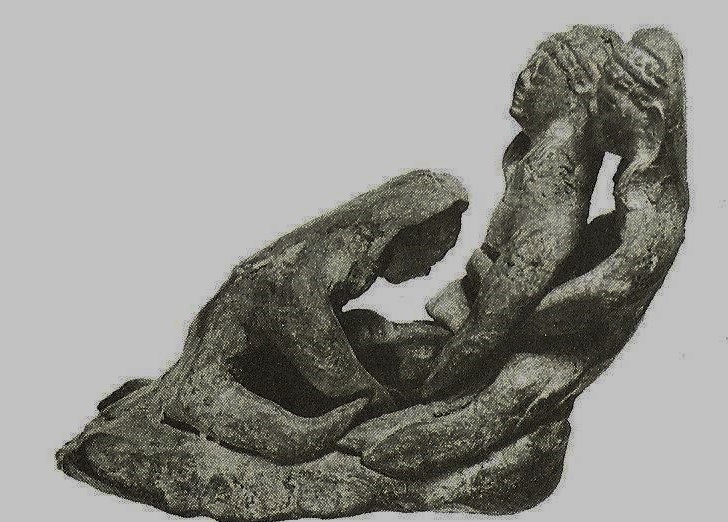
04.03.10.C. CLAY MODEL OF MOTHER IN CHILDBIRTH. A clay statuette from 8th century B.C. Cyprus depicts woman giving birth as two other women assist. (cf. Ex. 1:16; Gen 30:3). The birthing stool the pregnant woman sat upon is hidden. Basic functions of life were generally the same in all ancient Middle Eastern cultures. Mary may have delivered Jesus in a similar manner, since the custom did not change until modern times.
Modern readers of the infancy narratives often conclude that Mary and Joseph were alone in a barn when Mary gave birth. This was hardly the case. The idea that a woman who was about to give birth and did not have shelter or the assistance of other women in the village, was unthinkable in this culture. The facilities may have been meager, but generous Eastern hospitality is beyond Western imagination, especially in times of need. The classic example is found in Genesis 18 which records the encounter of Abraham and his guests.
It is unknown whether the couple got married in Nazareth, which would have been the most likely place since their families were nearby, or in Bethlehem (cf. Mt. 1:24-25). Even those who would normally have chided Mary for being unmarried and pregnant would have come to offer assistance. Since Joseph was related to nearly everyone in Bethlehem, all he probably needed to say was, “I am Joseph, son of Heli, son of Matthat, son of …” and they had an immediate welcome.
“Her firstborn Son,” Matthew clearly states that Mary and Joseph had a normal marital relationship after the birth of Jesus (a wedding is assumed). The fact that Jesus was her firstborn Son (Gk. prototokos 4416; Mt. 1:25; Lk. 2:7)[28] implies the subsequent birth of other children. These children were recorded to be with their mother[29] and some of their names are recorded in Matthew 13:55-56.
“Wrapped Him snugly in cloth.” This phrase has been used by some Bible translators to describe the clothing of the infant. In oriental custom, “The oriental swaddling clothes consisted of a square cloth and two or more bandages. The child was laid on the cloth diagonally and the corners were folded over the feet and body and under the head, the bandages then being tied so as to hold the cloth in position.”[30] Not to have been wrapped in swaddling clothes was a sign of being destitute or lack of parental care (Ezek. 16:4).
A Greek physician, Soranus, in Ephesus wrote a book titled On Midwifery and the Diseases of Women, in the A.D. 100s.[31] He described the basic techniques of childbirth that were in common use in all Middle Eastern cultures, and included the following comments,
- Use of a birthing stool or chair. The expectant mother never laid down to give birth; sitting on a birthing stool permitted gravity to help bring forth the child.[32]
- A midwife was directly in front of the mother and another woman was behind her to aid in the birthing process.
- As soon as the child was born the midwife cut the umbilical cord four finger-widths from the child’s belly and tied it with woolen yarn.
- The child was then cleaned with powdered salt, washed with warm water, and olive oil was rubbed onto the skin.
- Drops of olive oil were also placed in the eyes to wash away any reside from the uterus.
- The child was wrapped tightly in strips of cloth known as “swaddling clothes” for the first six months of life. This protected the child from eye injury that could be caused by fingers or finger nails. Hence, the child was wrapped in a manner that prevented arms and feet from moving. He was almost in a “mummy-wrap,” which also functioned as a diaper.[33]
- The child was then placed in a pillow filled with soft hay and laid in a feeding trough (manger).
While Soranus is credited for being a pioneer in ancient medicine, he may have attained some of his ideas from common folklore. For example, Ezekiel, speaking the word of the Lord to Jerusalem, said of that city,
On the day you were born your cord was not cut, nor were you washed with water to make you clean, nor were you rubbed with salt or wrapped in cloths.
Ezekiel 16:4
The prophet Ezekiel made the analogy of the Holy City to that of a newborn child. Clearly the child birthing practices mentioned by Soranus were common knowledge centuries earlier even in the Jewish culture. This custom was not only practiced by the Jews,[34] but also by the Egyptians, Parthians, Arabs, and other people groups. One time when teaching a class of Arab pastors in Jordan, this author asked if they were familiar with this method of wrapping a new-born infant. About half the students said that they had been wrapped in swaddling clothes when young. Today, however, disposable diapers are bringing this ancient tradition to an end.
“Laid Him in a feeding trough.” The word manger is often used in this verse, but it is an old English word meaning feeding trough for domestic animals.
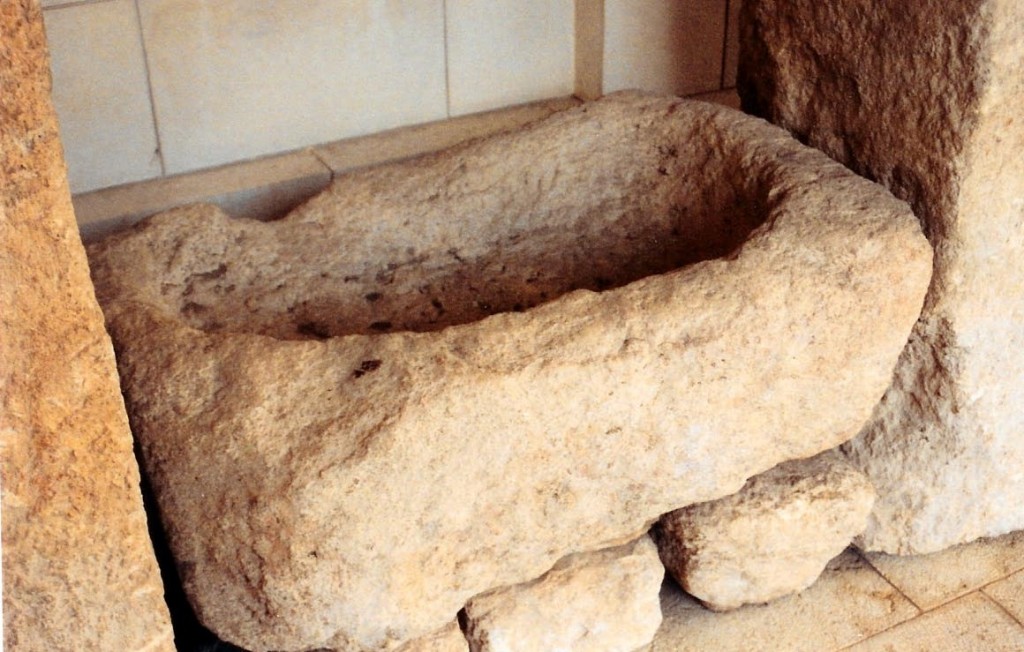
04.03.10.D. A TYPICAL STONE MANGER (FEEDING TROUGH). Mangers were feed troughs carved from a large limestone block as this one, or carved into the side of a cave, but were seldom made of wood. Animals, such as goats, donkeys, and oxen have a tendency to chew wooden objects and thereby destroy them. Jesus was most likely laid to rest on a bed of straw in a manger similar to this one found near Jerusalem. The newborn child would have been washed, gently rubbed with salt to prevent infection, and wrapped with a large soft cloth. This practice continued for several months.[35] Photograph by the author at the Rockefeller Museum, Jerusalem.
“Because there was no room for them at the lodging place.” Many English translations use the word inn, rather than lodging place, but both terms are misleading in terms of the cultural definition. The Greek word katalyma (2646) [36] meaning the guest room, as in the upper room of a private home – not a commercial enterprise. The term is also found in Mark 14:14 and Luke 22:11.[37] However, the usual Greek word for a commercial inn or hotel is pandocheion (3829), as found in the Parable of the Good Samaritan (Lk. 10:36). More specifically, the first part of pandocheion means all and the second part is a verb meaning to receive; essentially to receive all.[38] Luke stated that the guest room was already full, or occupied with other guests. With that term clarified, there are two possible reasons for the lack of decent accommodations that must be considered.
- The first and primary is the literal interpretation that they tried to stay with someone in Joseph’s family, and there was no room in anyone’s guest room. The custom of hospitality required that travelers be accommodated in private homes, as recorded throughout the Bible. Only in isolated places along major travel routes would there have been a commercial establishment that provided accommodation. Bethlehem was not along any significant travel route. A guest room was a small room on the house roof and inside was a bed, chair, and table. In 2 Kings 4:8-17 the Shunammite woman built an upper room or guest room for Elisha. The custom of a guest room is still prominent among some Arab villages today.
- In this culture, the birth of a child outside of marriage was considered shameful for the entire family and clan. People valued their family honor and tribal ancestry to such an extent that modern Westerners cannot comprehend the importance related to childbirth inside marriage. Therefore, if there was a question concerning Mary’s pregnancy prior to her wedding, it would have been natural for the extended family to reject the presence of Mary and Joseph and not take care of them. There is the possibility that the phrase “no room in the inn,” was an excuse so the young couple would not bring shame to the relatives. This strong sense of family honor and pride continues today. This interpretation, though, is a minority view.[39]
Hospitality was a sacred duty in the ancient Middle East. Whenever a traveler entered a village, it was not his responsibility to find a place to stay, but it was the duty of the villagers to invite him in for the night. The kindest and most gracious gift of modern hospitality can hardly match that of the biblical period – a social dynamic that is difficult for Westerners today to comprehend.
Some scholars have suggested that the English word inn was indeed a commercial resting area where camel caravan merchants could enjoy an inn and a bathhouse. (See the video 14.02.03.V where Dr. Heldt discusses the term “inn” as used in the infancy narratives and the term “upper room” of the Last Supper.) Such a facility for camel caravans was known as a caravanserai, or by its shortened name, a khan.[40] Khans were low one-story structures, built of rough stones or sunbaked bricks, and provided a safe enclosure for many camels. One large khan was discovered along the Sea of Galilee, and the ruins can still be seen at Khan Minyeh near Capernaum[41] and another at the Good Samaritan Inn along the Jericho to Jerusalem road.[42] However, there are three reasons for declining this interpretation to Bethlehem:
- No Greek or Hebrew words suggest a caravanserai.
- Bethlehem was not on a major trade route and, therefore, would not have been visited by caravans.
- Neither secular ancient writing nor archaeological discoveries suggest the possibilities of a khan in Bethlehem.
It has usually been assumed that Mary and Joseph could not find a place to stay because so many also traveled to Bethlehem for the census. But this may not have been the reason for lack of accommodations. As indicated elsewhere, this writer provided evidence to show that Jesus was born during the Feast of Tabernacles fulfilling the prophecy that one day our Lord would “tabernacle” with His people (Ezek. 37:27). Severe lack of accommodations would have been more typical during the three pilgrimage feasts: Pesach (Passover), Shavuot (Pentecost), or Sukkot (Tabernacles, also known as Booths). During these times Jerusalem was so over-crowded that many of the surrounding villages, such as Bethlehem, hosted pilgrims who could not find accommodations in the Holy City. However, some scholars believe that since the first and last days of the feast were deemed to be “Second Sabbaths,” those staying outside of the Holy City had to be within a Sabbath’s Day walk of the city walls. That distance is about 2,000 cubits, or 3,000 feet, but Bethlehem was six or seven miles distant.
However, a question arises for which there is no answer: If there was no room in Bethlehem, why didn’t Joseph take Mary to the home of Elizabeth and Zechariah? They lived much closer to Jerusalem. A quick response might be that Jesus had to be born in Bethlehem to fulfill ancient prophecies. But did Joseph know that? How much knowledge of the prophecies related to Jesus did Mary and Joseph understand at this time? Based upon the conversation they had with Him twelve years later in Jerusalem, obviously it was limited. Did they know their child was Deity on earth? These assumed answers make one return to the original question as to why Joseph did not consider taking Mary to the home of Zechariah and Elizabeth until a better accommodation could be found. If they did, then after the birth, they could have traveled to Bethlehem to register for the census. The answer may never be known.
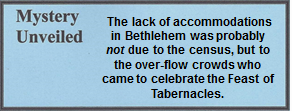
Finally, Matthew said that when the magi arrived they entered a house (Mt. 2:11). Evidently a sufficient amount of time had transpired following the birth to allow Joseph to move his family to better dwelling quarters.[43] Jesus was born in a stable that evidently was not part of a house, and eventually the Holy Family moved into a simple house, typical of Middle Eastern homes.
04.03.10.Q2 Why was Jesus born?
This question is obviously of a theological nature. However, to summarize, Jesus was born to reveal God the Father to mankind (Jn. 1:18), to redeem mankind from sin (Jn. 1:19; 3:16), to bring all people unto Himself, and to rule His kingdom (Mt. 3:2-3; Jn. 18:37). He was born, that He could die, that you could choose to live with Him forever.
04.03.10.Q3 When was Jesus born?
The answer is presented in two parts:
- What year was Jesus born?
- What time of year was Jesus born?
The question has been often raised that … if Jesus was such an important figure in history, why doesn’t anyone remember His birthday? The answer lies in the fact that in the Hebraic culture, the date of one’s death was remembered and observed rather than the date of one’s birth. Nonetheless, a scholarly attempt has been made to calculate his date of birth, and while one cannot be dogmatic about the conclusion, there is a better than average probability that it is correct.
- The popular opinion today is that December 25 is the all-important birth date. This date was promoted by Hippolytus (A.D. 165-235), and became official by Constantine the Great in his attempt to eradicate Christianity’s Jewish roots and because this date was already a pagan Roman holiday. Likewise, Constantine separated the death and resurrection date of Jesus from Passover and renamed it “Easter” in honor of the Babylonian god Ishtar, and placed it on an earlier date for celebration.
- But not all agreed with Constantine. For centuries the Eastern Orthodox Church celebrated the birth on January 6. According to their tradition, it was on this same date two years later that the magi visited the Christ child.
- Another opinion was promoted by church father Clement of Alexandria in about A.D. 200. In his book Stromata, he recorded that Jesus was born in the twenty-eighth year of the reign of Augustus and on the 25th day of Pachon of the Egyptian calendar, which is reconciled to May 14, 6 B.C. on the modern Julian calendar.[44] This may be farfetched, but it is a better estimate than December 25.
Since Matthew mentions a star, there have been numerous attempts to calculate the date He was born with a celestial light. Halley’s Comet passed by in 11 B.C. and other comets were seen in 44 B.C., 17 B.C., and A.D. 66. Supernovas have been calculated as well as alignments of planets. But, as will be shown, all these attempts have failed.
But the secret to determining the date of His birth is not in the star, but with the ministry of Zechariah. As will be shown, it is important to determine the date of the birth of John the Baptist (see 04.03.06.Q1), then count forward. By the process of calculating parameters, a time window is established in which the birth occurred. Significant events that have been verified are delineated below which lead to an accurate estimated date. As various events are evaluated, by the process of elimination, the time window is narrowed.
What year was Jesus born?
- Josephus said that Herod the Great reigned 37 years from the time of his appointment (in 40 B.C.) and 34 years after his conquest of Jerusalem.[45] This clearly places his death exactly within the time frame of 4 B.C.
- Since the magi came to Herod’s Jerusalem palace, it is obvious that Herod was alive with no indication of any illness. His death has been calculated to March 4 B.C.; because Josephus recorded that there was an eclipse of the moon on March 13.[46] This was shortly before Passover,[47] so Jesus had to have been born prior to the eclipse in 4 B.C.[48]
- It is a well-established historical fact that Herod’s three sons began their reigns in 4 B.C.; each over a segment of land inherited from their father. This also confirms that Jesus was born prior to 4 B.C.
- It is a well-established fact that Herod’s son Archelaus was removed from office by Caesar in A.D. 6, when he was in his tenth year of reign.[49] Therefore, he began his rule at age 18 over Judea and Samaria in 4 B.C. Furthermore, before he could begin his reign, the Roman senate had to approve his late father’s will and authorize his appointment to the throne. All this occurred in 4 B.C.
- According to Josephus, prior to his death, Herod lived in Jericho where he died of an excruciating disease. Scholars believe his stay there was approximately a year, possibly a little less. Since the magi visited him in Jerusalem, this would place the birth of Jesus prior to the year 5 B.C.[50]
- The Census Decree of Quirinius was in 8 B.C. Therefore, Jesus must have been born between the years 8 and 5 B.C., and in all probability, in 6 B.C.
- When the magi left Herod, Jesus was less than two years old.
- The command by Herod to kill boys 2 years and younger suggests that the magi may have seen the star for two years. In biblical times mothers often nursed their infants until the age of two.[51] Some ancients believed that when a king was to be born, strange events could be noticed in the night heavens.
- Therefore Jesus must have been born between the years 7-5 B.C.
In addition to these parameters, scholars have also considered the following clues:
- Herod the Great began rebuilding the temple in 20/19 B.C. The Pharisees in John 2:13-35 stated that it had been 46 years since reconstruction began.[52] When adjusted to the modern calendar, that conversation took place in the year A.D. 27 or 28, in the 15th year of the reign of Tiberius.[53]
- If Jesus was precisely thirty years old when He began His ministry in the year A.D. 27/28, then His birth year had to have been in 3 or 4 B.C. or earlier. However, this writer suggests that since the Bible says that He was “approximately” 30 years old, He was in fact, older. Since John the Baptist could not begin his ministry until the age of 30, and he preached over a year before Jesus began, obviously Jesus was 31 years old or older. Josephus said that priests and Levites served between the ages of 30 and 50.[54] Remember, they were only 6 months apart. All that said these events place the year of His birth into the 7-5 B.C. time window.
The pregnancy of Elizabeth is the most significant clue, which has been overlooked historically, and is again presented below.[55] A growing number of scholars believe that Jesus was born in the autumn of the year. Carefully follow the outline of events to see why.
What time of year was Jesus born?
- The father of John the Baptist, Zechariah, was a priest who served in the eighth rotation of Abijah (1 Ch. 24:10). There were twenty-four groups, called courses, of priests who served in the temple twice a year for one week. Josephus reported that each week consisted of two Sabbaths, in essence – an eight day week.[56]
- Jewish records indicate that the first course of priests served in the first half of the month of Nissan, the first month of the Jewish religious calendar. Zechariah’s group was scheduled for service in the second half of the Hebrew month of Tammuz.
- After completing his tour of priestly duty at the temple, Zechariah came home and soon thereafter, his wife became pregnant (Lk. 1:23-24). The conception would have occurred approximately on the first day of the Hebrew month of Av.
- Six months into her pregnancy (Lk. 1:26, 36), her cousin Mary (Heb. Miriam) also became pregnant, which would have been in the first half of the month of Tevet.
- Mary quickly traveled to visit Elizabeth who was now pregnant after being barren all her life (Lk. 1:39). Mary stayed with Zechariah and Elizabeth for three months until Elizabeth gave birth to John (Lk. 1:56-57).
- Nine months after the month of Av, John was born in the month of Nissan, during the time of Passover. Every year at the Feast of Passover a passage was read in the synagogues that said, “Behold, I am going to send you Elijah the prophet before the coming of the great and terrible day of the Lord.”
- Therefore, Jesus was born six months later on the 15th of the month of Tishri at the beginning of the Feast of Sukkot, also known as the Feast of Tabernacles. The Feast commemorated the time when the Israelites lived in booths, also known as Tabernacles that were hastily constructed from palm branches and other vegetation, as they left the bondage of Egypt. Too often the focus has been on their hindsight, coming out of bondage, rather than foresight in that they were going to enter a new era living in the freedom of the land promised to them by Abraham.[57] More importantly, the fall festival celebrated “God living with us” – the definition of Immanuel.
There is further insight to support the theory of His birth on this festival. While most scholars believe He ministered for three and a half years, there are others, including this writer, believe that four and a half years of ministry may be more accurate. Regardless, everyone believes it was a certain number and a half years. Since Jesus was crucified on the spring festival of Passover, that one-half year difference would have placed His birth on or about the time of the Feast Tabernacles.
The implication is strengthened in John 1:14 where the gospel writer recorded that Jesus dwelled or “tabernacled” among men. What better time for Jesus to have been born than when He “tabernacled” with His people?
While the above calculation is based on historical and sequential logic, there are two other observations to support this conclusion.
- The Feast of Tabernacles, also known as Weeks or Sukkot, is a feast of joy. There is a Hebrew wordplay in Scripture in that the angels told the shepherds that this was a season of great joy (Lk. 2:10).[58] The “Season of Great Joy” is synonymous with the Feast of Tabernacles (Sept. – Oct).[59]
- Another point is that while the Israelites were wandering around in the desert for 40 years, God was in the midst of them and His presence was in the tabernacle, a huge tent. The twelve tribes were camped round about the tabernacle. Just as God lived among men in the desert, Jesus came to live among men in the Promised Land during the Feast of Tabernacles.
Therefore, according to those who study the Jewish roots of Christianity, the Christmas celebration of the birth of Jesus living among men should coincide with the Jewish Feast of Tabernacle celebration rather than with December 25. Just as God lived among men in the desert, Jesus came to live among men in the Promised Land during the Feast of Tabernacles.
Finally, many scholars have attempted to determine the date of the birth of Jesus to a lunar eclipse,[60] since Josephus said that an eclipse occurred near the time of death for Herod the Great.[61] Within the possible time frame there were four eclipses: September 15, 5 B.C., March 12-13, 4 B.C., January 10, 1 B.C, and December 29, 1 B.C. Since his passing was just prior to Passover, only the March date can be taken seriously. However, a few scholars have argued for a 1 B.C. date,[62] but the arguments against this position are as follows.
- Since Herod the Great died shortly before Passover which is in the springtime,[63] the lunar eclipse in March of 4 B.C. is a better candidate than any other month.
- The historian said that Herod reigned 37 years from the time of his appointment (in 40 B.C.) and 34 years after his conquest of Jerusalem.[64] This clearly places his death exactly within the time frame of 4 B.C.
- It is a well-established fact that Herod’s son Archelaus was removed from office by Caesar in A.D. 6, when he was in his tenth year of reign.[65] Therefore, he began his rule at age 18 over Judea and Samaria in 4 B.C. Furthermore, before he could begin his reign, the Roman senate had to approve his late father’s will and authorize his appointment to the throne. All this occurred in 4 B.C.
[1]. Smith, Augsburg Commentary on the New Testament: Matthew. 39.
[2]. Payne, “Bethlehem.” 1:189.
[3]. Significant to the research of place names is the fact is that ancient names of Jewish villages, rivers, and mountains remained unchanged, even after the Arab (Muslim) invasion. The new arrivals often modified Jewish place names with Arabic names and, therefore, researchers quickly identified biblical sites that had been abandoned for centuries.
[4]. Pentecost, The Words and Works of Jesus Christ. (Video, “B”).
[5]. Cranefield, “Bread.” 37.
[6]. Young, The Jewish Background. 24; Vine, “Bread.” Vine’s Complete Expository Dictionary. 2:77.
[7]. Tenney, ed., “Bethlehem.” 2:273-74.
[8]. The keeping of animals in caves or in a home was common practice throughout the entire ancient Middle East, and there have been numerous archaeological excavations that confirm this.
[9]. Tenney, ed., “Bethlehem.” 2:273.
[10]. Barclay, “Matthew.” 1:25.
[11]. Duffield, Tourist’s Handbook. 59; Achen, The Holy Land. 20.
[12]. Masterman, 1:472-73.
[13]. Maier, In the Fullness of Time. 34.
[14]. Ante-Nicene Fathers, 1:237.
[15]. Thompson, “Manger.” 2:944.
[16]. Origin, Against Celsus 1:51; Also found in the Ante-Nicene Fathers: The Writings of the Fathers Down to A.D. 325. 4:418.
[17]. Cave where God spoke to Moses (Ex. 33:21-23); The cave of Lot (Gen. 19:30); Machpelah – Abraham’s tomb (Gen. 23:19); Makkedah – A hiding place of kings (Josh. 10:16-17); En Gedi – A hiding place for David (1 Sam. 22:1); Obadiah’s large cave where he hid 150 prophets (1 Kg. 18:4).
[18]. Bailey, Jesus through Middle Eastern Eyes. 263.
[19]. Maintaining animals in or close to human living quarters was not limited to ancient times. The author’s father and grandfather lived in Banfe, Germany, where in the 19th century, the barn and living quarters were adjacent to each other within the same building.
[20]. Schneemelcher, New Testament Apocrypha. 2:370-88.
[21]. Bailey, Jesus through Middle Eastern Eyes. 76.
[22]. Protoevangelium of James 19:1, 2, 3; 20:4; 21:3. The text makes use of the narratives familiar to us from Matthew and Luke, as well as the traditions of the time. To this, the writer added a creative but false account of the so-called miraculous birth of Mary and her marriage to the so-called widower Joseph. The reader must separate the creative writing from what is biblically and historically correct. The author of Protoevangelium was neither Jewish nor the disciple James.
[23]. The reader is reminded that quotations from non-biblical sources are not to be understood as being of equal authority with the biblical narratives. See 01.02.04.
[24]. Finally, the Protoevangelium of James, a popular apocryphal gospel written in the latter half of the second century records the story of the birth of both Mary and Jesus. Historians generally believe that factual events and places – such as the cave and the presence of a midwife – are probably true but the quotations are probably rather fanciful. See Protevangelium of James in Appendix 26.
[25]. It is considered by the author to be “supportive evidence,” not “primary evidence” that supports the argument that Jesus was born in a cave or in a house with a cave. See previous footnotes.
[26]. Bailey, Jesus through Middle Eastern Eyes. 74-79.
[27]. Packer, Tenney, and White, eds., The Bible Almanac. 440-49.
[28]. Vine, “First-Begotten, Firstborn.” Vine’s Complete Expository Dictionary. 2:240.
[29]. Mt. 12:46; Mk. 3:32; Lk. 8:20.
[30]. Garland, “Swaddling.” 4:670; Bailey, “The Manger and the Inn.” 99-106.
[31]. Miller, The Jesus of the Bible. 55-57; See also http://www.afn.org/~afn32612/Childbirth.htm#15 Retrieved February 14, 2012.
[32]. Soranus as retrieved from http://www.afn.org/~afn32612/Childbirth.htm#15 Retrieved February 14, 2012; http://www.britannica.com/EBchecked/topic/428594/On-Midwifery-and-the-Diseases-of-Women. Retrieved September 21, 2013.
[33].http://www.britannica.com/EBchecked/topic/428594/On-Midwifery-and-the-Diseases-of-Women Retrieved Feb. 14, 2012.
[34]. Concerning medical procedures available in the first century Israel, a number of good resources have been published by the University of Haifa, Hebrew University, and the Israel Museum. For further study, see the articles published in Michmanim, (English and Hebrew), Haifa, ISRAEL: University of Haifa (Vol. 13) May, 1999.
[35]. Packer, Tenney, and White, eds., Nelson’s Illustrated Encyclopedia. 444-45; Thompson, “Manger.” 2:944.
[36]. Vine, “Guest Chamber.” Vine’s Complete Expository Dictionary. 2:285 and “Inn” 2:326.
[37]. For more information on a typical upper room, see video 04.07.01.V2; Cosby, Interpreting Biblical Literature. 10, 14.
[38]. Bailey, Jesus through Middle Eastern Eyes. 32; Vine, “Guest Chamber.” Vine’s Complete Expository Dictionary. 2:285 and “Inn” 2:326.
[39]. Willmington, Willmington’s Guide to the Bible. 18-19.
[40]. Farrar, The Life of Christ. 98.
[41]. The ruins of Khan Minyet, also known as Khirbat al-Minya, were built by Muslims between 705 and 715. However, some scholars believe that since the international highway, the Via Maris, existed for more than a millennium before Christ, another caravanserai must have existed at or near Capernaum to serve the traveling caravans; See also Vincent, Word Studies in the New Testament. 1:268.
[42]. The last structure on the site of the Good Samaritan Inn, prior to restoration by the state of Israel, was a khan, or camel caravan way station, built by the Sultan Ibrahim Pasha (1494-1536) of the Ottoman Empire. Archaeologists have demonstrated that the site had been a rest area for well over a millennia.
[43]. Stein, R. Jesus the Messiah. 53; Edersheim, The Life and Times of Jesus the Messiah. 145.
[44]. Ante-Nicene Fathers 2:333. See Appendix 1 for dates of reign. Franz, http://www.lifeandland.org/2009/02/the-angelic-proclamation-to-the-shepherds-luke-28-15/ Retrieved June 15, 2010.
[45]. Josephus, Antiquities 17.8.1 and Wars 1.33.8.
[46]. Josephus, Antiquities 17.6.4-5.
[47]. Josephus, Antiquities 17.9.3 and Wars 2.1.3.
[48]. To add fuel to the debates there were four eclipses: September 15, 5 B.C., March 12-13, 4 B.C., January 10, 1 B.C, and December 29, 1 B.C. Since Herod’s death was just prior to Passover, only the March date can be taken seriously.
[49]. Dio Cassius, Roman History 55.27.6; Josephus, Antiquities 17.13.2.
[50]. Josephus, Antiquities 17.6.5.
[51]. Smith, Augsburg Commentary on the New Testament: Matthew. 43.
[52]. The remodeling of Herod’s temple took more than 80 years. It was completed six years prior to its destruction in A.D. 70.
[53]. Snodgrass, “The Temple Incident.” 447.
[54]. Josephus, Antiquities 7.14.7 (363).
[55]. See previous comments on 04.03.06.Q1 “When was John the Baptist Born?”
[56]. Josephus, Antiquities 7.14.7 (365); It should be noted, that of the original courses, only four returned from Babylon (Ezra 2:36-39). Therefore, the other courses were with the same names as previously used. For further study, see Geikie, The Life and Works of Christ. 1:86-87.
[57]. Garr, Restoring Our Lost Legacy. 149.
[58]. Barclay, “Matthew.” 1:13.
[59]. See Appendix 5; Chumney, The Seven Festivals of the Messiah. 180-86.
[60]. In an interesting side note, The New York Times reported in late November, 2014 of a mechanical device built by the Greeks around 205 B.C., that was able to predict eclipses. Researchers James Evans, professor of Physics at University of Puget Sound, and Christian Carman, history of science professor at University of Quilmes, Argentina, said the computer-like device made predictions on Babylonian arithmetical methods borrowed by the Greeks, not on Greek trigonometry. There are no enlightening comments on the star of Bethlehem or the darkness of Good Friday, but it did predict lunar and solar eclipses. Cited by Bullinger, Clyde, ed. “Clues to an Ancient Greek Riddle” Artifax. 30:1 (Winter, 2014). 12, 14.
[61]. Josephus, Antiquities 17.6.4.
[62]. Simmons, “The Origins of Christmas and the Date of Christ’s Birth.” 310-14, esp. 312.
[63]. Josephus, Antiquities 17.9.3 and Wars 2.1.3.
[64]. Josephus, Antiquities 17.8.1 and Wars 1.33.8.
[65]. Dio Cassius, Roman History 55.27.6; Josephus, Antiquities 17.13.2.
